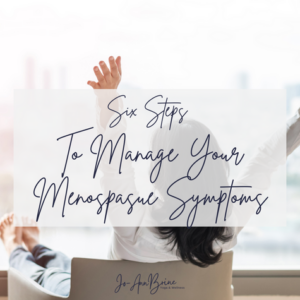
by Jo-Ann Brine | Menopause, Midlife, Yoga |
Let’s be real for a second — feeling stiff, tired, and just “off” as you get older can be SO FRUSTRATING.
One day you’re bouncing out of bed ready to conquer the world… and the next, your knees are popping like popcorn, your back is cranky, and your energy’s nowhere to be found.
Sound familiar??? You are NOT alone.
But here’s the good news: you don’t have to train like a 25-year-old or hit the gym for hours to feel strong, vibrant, and confident in your body again.
In fact, the secret sauce to aging well (and feeling better than ever!) is something simple and super doable…
Moving your body—Every. Single. Day.
No, not punishing workouts.
Not bootcamps or burpees.
I’m talking about gentle, powerful, at-home movement that builds strength, supports your joints, improves your balance, and YES — boosts your energy like a cup of coffee.

Let’s talk about the best types of movement for women 40 and beyond — and exactly how you can get started today, right in your living room!

Why movement matters more after 40
Okay, let’s talk about the WHY.
Once we hit menopause (and beyond), our bodies start going through all kinds of changes — hormone shifts, bone density drops, muscle mass loss (hello, wobbly arms), and a metabolism that suddenly feels like it’s running in slow motion.
But here’s what many women don’t realize: movement is medicine. It’s one of the most powerful tools we have to fight back against aging.
Daily movement can help you:
- Build lean muscle (hello, toned arms and strong legs!)
- Strengthen your bones (goodbye, osteoporosis worries)
- Reduce joint pain and stiffness
- Improve posture and balance (fewer falls = more freedom!)
- Boost your mood and energy
- Sleep better
And let’s be honest… feel WAY more confident in your skin!
So let’s dive into the best types of movement to work into your week.
1. Strength Training (YES, You need it!)
You don’t need to lift heavy weights to be strong. But your body LOVES resistance — especially after 40.

Strength training helps maintain and build lean muscle, supports your joints, and keeps your metabolism humming.
Plus, it’s AMAZING for bone health.
Try this at home:
- Bodyweight squats (or sit-to-stands from a chair)
- Wall push-ups or kitchen counter push-ups
- Standing rows with resistance bands
- Step-ups using stairs or a sturdy step stool
👉 Start with 2-3x per week for 10–20 minutes. You’ll be surprised how fast your strength comes back!
2. Mobility and Flexibility Work
Mobility is what keeps you moving well. It’s about maintaining a full range of motion in your joints so you can twist, reach, and bend without pain.

Think of it like WD-40 for your body — a little movement oil to keep things running smoothly.
Try this at home:
- Cat-cow stretches on hands and knees (great for the spine!)
- Gentle neck and shoulder rolls
- Hip circles
- Standing side bends
- Ankle circles while seated
Add these in daily, even if just for 5–10 minutes. Your body will thank you.
3. Yoga (Your Secret Superpower)
If you haven’t tried yoga lately (or ever), I promise — it’s not just for 20-somethings on Instagram. Yoga is INCREDIBLE for midlife women.

It builds strength, improves flexibility, calms the nervous system, and helps you reconnect with your body in a way that feels empowering (not punishing).
Try this at home:
- Downward dog
- Warrior poses
- Bridge pose
- Legs up the wall (amazing before bed!)
You can do yoga with a chair, on a mat, or even in bed. There are so many styles — find one that feels good for YOU.
4. Balance Training (So you can stay on your feet!)
Falls become more dangerous as we age. But good news — balance is a skill, and like any skill, you can train it.

Just a few minutes a day can improve your stability and confidence walking, hiking, climbing stairs — all the things that make life FUN.
Try this at home:
- Single leg stand (hold onto a counter for support)
- Heel-to-toe walk in a straight line
- Side leg raises
- Stand on a pillow or folded towel for an extra challenge!
Bonus: many strength and yoga moves improve balance at the same time.
5. Walking (The Queen of Movement!)
Never underestimate the power of a good walk.

Walking is one of the BEST exercises for your heart, your brain, your bones, and your soul. It boosts circulation, clears your mind, and gives your joints a low-impact, feel-good workout.
Try this:
- Morning walk around the block to boost energy
- 10-minute “movement snacks” throughout the day
- Listen to a podcast, call a friend, or enjoy nature — multitasking at its finest!
Aim for 30 minutes a day, but remember: EVERY step counts.
How to stick with it (Even on the hard days)
Let’s be honest. Starting something is easy. Sticking with it? That’s where most of us fall off.
But here’s the thing: You don’t have to do it perfectly. You don’t need to work out for an hour. You don’t even have to break a sweat.
You just need to show up. A little movement every day adds up BIG TIME.
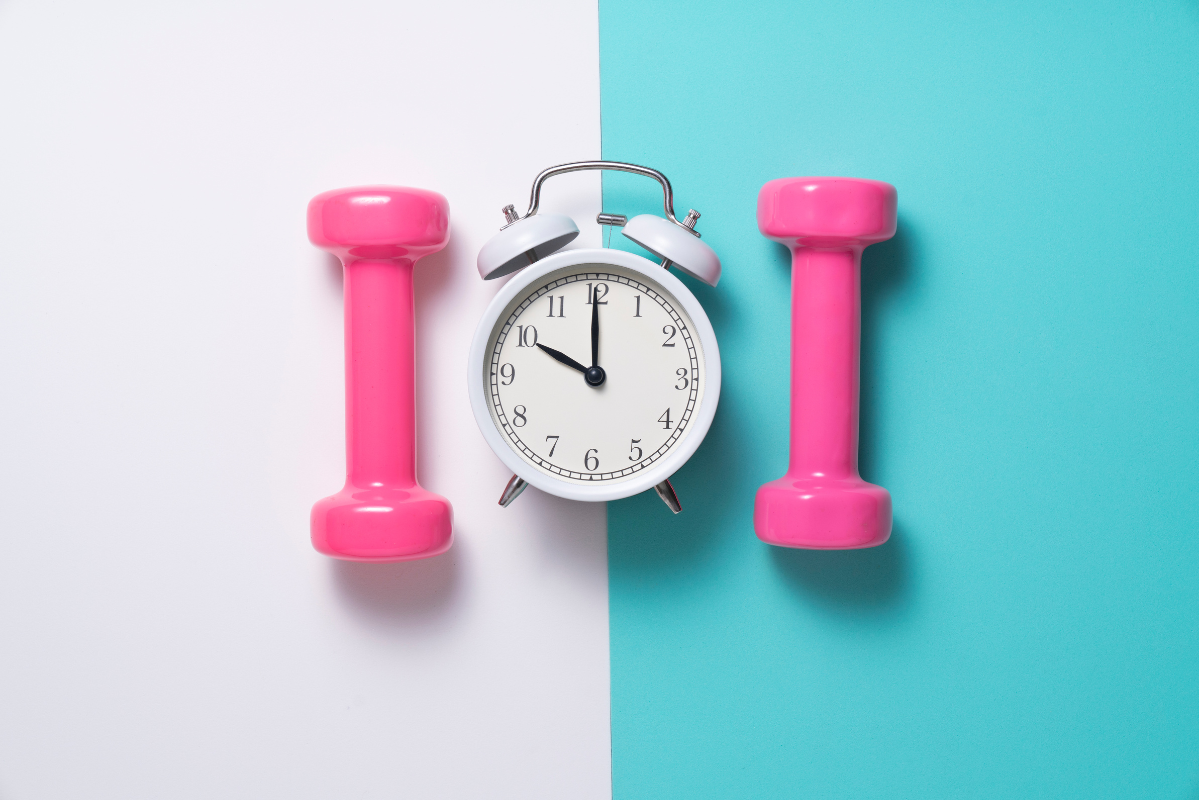
Here are some tips:
- Set a reminder on your phone
- Lay out your mat or workout clothes the night before
- Invite a friend to join you (accountability helps!)
- Keep it FUN — play your favorite music!
- Celebrate the little wins: “I moved today. I showed up. I did that.”
REMEMBER, This is about feeling amazing
You don’t have to be perfect.
You don’t need a gym membership.
You don’t need to do what everyone else is doing.

You just need to move YOUR body in a way that feels good and supports your long-term health. You deserve to feel strong, capable, and FULL of energy — not just for today, but for decades to come.
Ready to feel strong, flexible, and full of life?
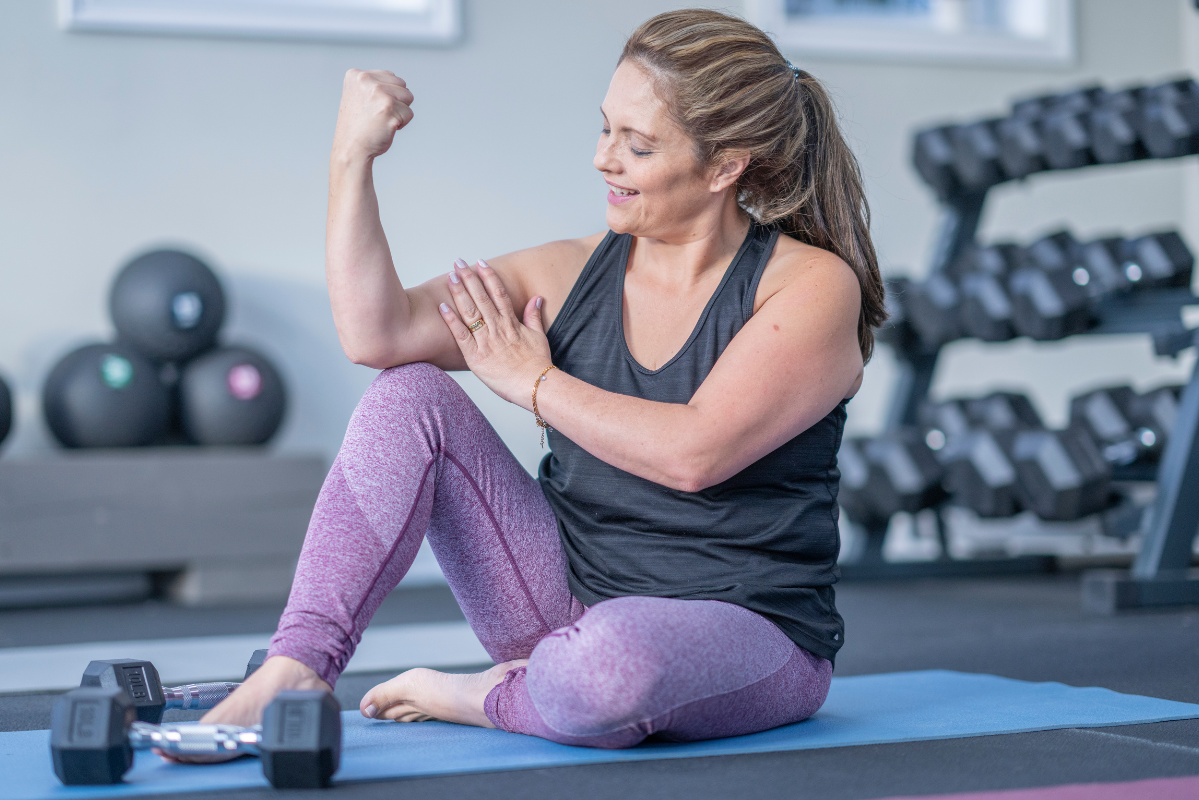
You don’t have to figure this all out alone — come join us inside The Midlife Wellness Lounge, our FREE Facebook group created just for women in midlife who are ready to move more, stress less, and feel GOOD again.
Inside, you’ll find:
✅ Simple, doable at-home workouts
✅ Weekly wellness tips that actually work
✅ Fun Challenges to help you stay on track
✅ Mini Classes and Courses to guide your journey
✅ And a whole lotta support from women who get it!
This is YOUR space to feel empowered, encouraged, and connected as you build strength, energy, and confidence in this amazing chapter of life.
💖 We’d LOVE to have you inside!
👉 Click here to join The Midlife Wellness Lounge
PLUS… don’t forget to grab your FREE Longevity Starter Kit!
This powerful guide will walk you through the exact habits and simple shifts that support energy, strength, and vibrant health in midlife — no overwhelm, no confusion, just real-life tools that work.
👉 Download the Starter Kit here!
Let’s keep moving, growing, and glowing — TOGETHER. 🎉💪🌸
See you in the Lounge, friend! 💪💃🌟
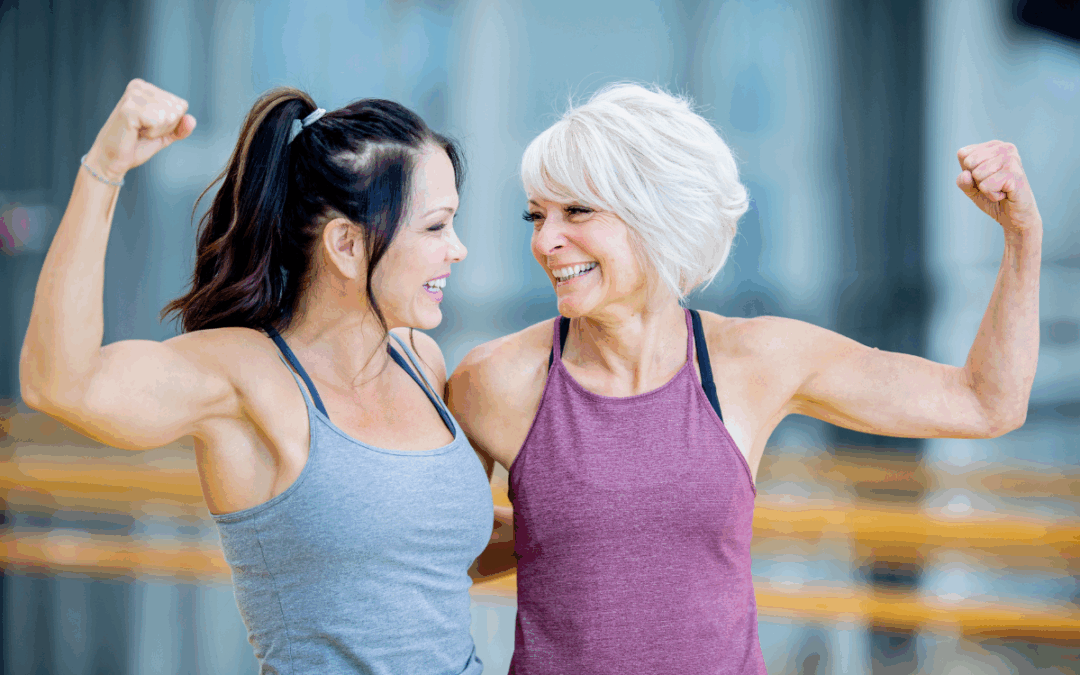
by Jo-Ann Brine | Midlife |
Let’s be real for a second…
Life is a lot.
You’re juggling responsibilities, feeling the pull of work (even if you’re “retired”), family, aging parents, maybe grandkids… your body doesn’t bounce back like it used to, and honestly? The world feels kinda LOUD these days.
Stress sneaks in like a ninja and BAM!!! Your shoulders are up around your ears, you’re snapping at your partner, and you can’t remember the last time you slept through the night.
Sound familiar?
If you’re in your 40s, 50s, or 60s and thinking, “Why do I feel so tense all the time? And what the heck is it doing to my health?”—this is for YOU.
Let’s talk about stress. Not in a doom-and-gloom way (you get enough of that already). But in a take-back-control kinda way. Because here’s the truth:
Chronic stress is not just a mood killer. It’s a LIFE SHORTENER.
Yep. If you’re constantly stuck in stress-mode, it impacts everything from your heart health and immune system to your brain, digestion, sleep, hormones, and even how fast you age.
But the good news? You can change that. You can totally turn it around—without running away to a spa or meditating on a mountain top for 30 days. (Unless you want to, of course.)
Let’s break down what stress is doing to your longevity—and some simple, doable daily practices that can bring you back to center.
So, What’s Stress Actually Doing To You?

Think of stress like an alarm system in your body. A little stress is okay—helpful even. It helps you react to danger or get stuff done.
But when the alarm stays ON all day, every day? That’s when the damage happens.
Here’s what chronic stress does to your body (and why you feel the way you do):
- Raises cortisol levels, which makes it harder to lose weight (especially that stubborn belly fat), messes with your sleep, and increases inflammation (a.k.a. aging from the inside out).
- Wrecks your immune system, making you more vulnerable to illness.
- Interrupts your hormones (yep, menopause and stress are BFFs… in the worst way).
- Speeds up cellular aging (hello, wrinkles, foggy brain, and low energy).
- Zaps your joy, your creativity, and that feeling of calm you’ve been craving.
The bottom line? If we want to live long and strong, we’ve got to learn how to dial it down.
Okay… So How Do We Actually Stress Less?

Let’s make this super practical. Here are a few powerful but EASY ways to de-stress daily—no equipment required.
1. Breathe Like You Mean It
If you do NOTHING else—start here.
Your breath is your built-in chill button. It literally signals your nervous system to calm the heck down.

Try this: Inhale for 4 counts. Hold for 4. Exhale for 6. Repeat for 2-3 minutes.
This slows your heart rate, lowers cortisol, and helps you feel safe again.
Do it first thing in the morning, in the car, before a meeting, or when you want to strangle someone at Costco. It works wonders.
2. Move Your Body Gently (and Often)
No, you don’t have to do burpees or train for a marathon.

Gentle movement like yoga, walking, stretching, or even dancing in your kitchen reduces cortisol and boosts your feel-good hormones like serotonin and dopamine.
The key? CONSISTENCY. A little every day is better than one hardcore session once a week. Get out of your head and into your body—even if it’s just for 10 minutes.
3. Create a Morning “You Time” Ritual
Before you check your phone, scroll social media, or turn on the news… give yourself 10 minutes.

- Breathe.
- Sip warm lemon water.
- Write down 3 things you’re grateful for.
- Read something uplifting.
- Stretch or go for a walk.
Your nervous system will thank you. Your family might too. 😉
4. Talk to Yourself Like Someone You Love
This might be the most important shift of all.
You can drink green juice, walk daily, and do all the breathwork—but if the voice in your head is constantly criticizing you? That’s stressful.

Start catching those mean-girl thoughts and replacing them with compassion:
“I’m doing the best I can.”
“My body is allowed to change.”
“Slow is still progress.”
“I am learning how to take care of myself in this season.”
You don’t need to be perfect. You just need to be kind to yourself.
5. Unplug (On Purpose)
We’re constantly bombarded with noise—texts, emails, news, social media… it’s overstimulating our brains and frying our nerves.

Try setting boundaries like:
- No phone for the first hour of the day. Too big of a leap? Then start with the first 10-15 minutes of your day…baby steps.
- Social media-free Sundays.
- 30-minute screen-free wind-down before bed.
You’ll be amazed how much calmer you feel.
Remember: Peace Is a Practice
You don’t need to “fix” everything overnight. And you’re not doing it wrong because you still get stressed (you’re human!).
The goal isn’t a stress-FREE life.

The goal is a life where you know how to come back to yourself… to breathe, reset, and move forward with a little more grace.
Because here’s what I know for sure:
Women who learn how to manage their stress don’t just live longer. They live BETTER.
More energy. Less inflammation. Better sleep. Clearer thinking. Stronger bodies. And yes—more laughter, more joy, more LIFE.
And that’s what you deserve.
💛 Ready to Feel Calmer, Stronger, and More in Control?
If you’re craving less tension, better sleep, and more energy to enjoy your life (without adding more to your already-full plate)… I’ve got something for you.
I created a free downloadable guide just for women in midlife who are ready to stress less and live more—with simple, daily practices that actually fit your season of life.
✨ Download your copy of our Stress Guide
Inside, you’ll find easy tools to calm your mind, support your hormones, and feel more like you again.
👉 [Grab Your Free Guide Here]
And if you’d love more support, come join our private Facebook Group—a welcoming space where like-minded women share real-life strategies, encouragement, and lots of laughter.
Let’s build a calmer, stronger, longer life—together.
You’ve got this 💛
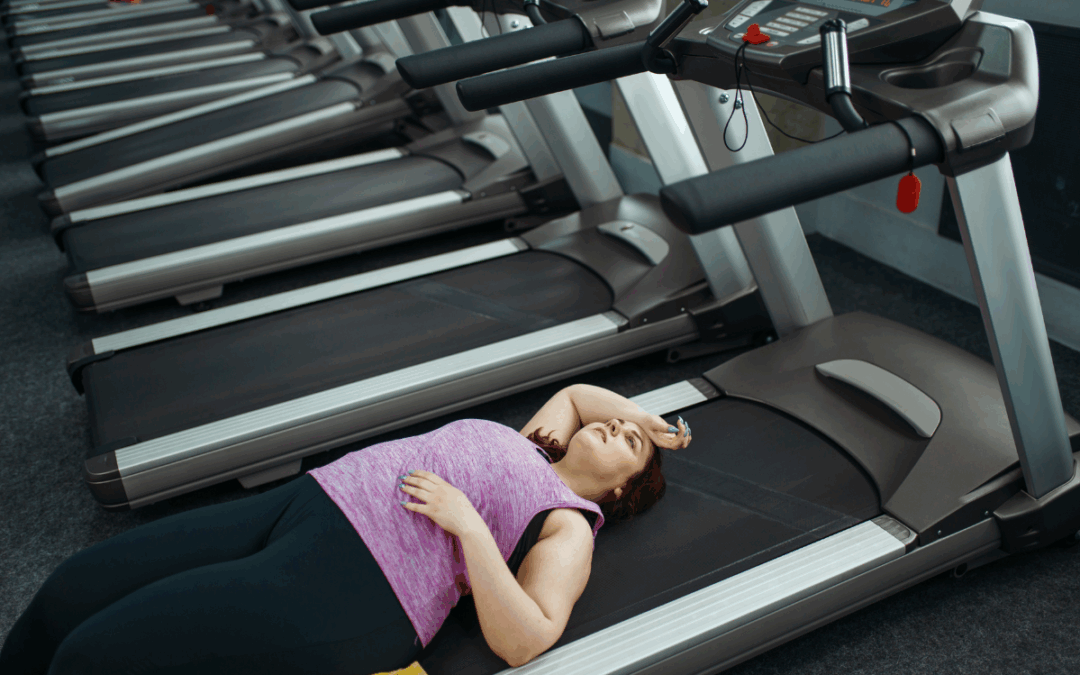
by Jo-Ann Brine | Menopause, Midlife |
You know that feeling when you wake up and everything just… aches?
The joints are creaky, energy is low, and the idea of “getting in shape” feels about as realistic as running a marathon tomorrow?
If that sounds familiar—you are so not alone.
For many women in midlife, movement starts to feel harder than it used to. You might think, “I’m too out of shape to exercise” or “It’s too late to start now.” But I’m here to gently remind you:
IT’S NEVER TOO LATE. AND YOU’RE NOT TOO STIFF, TOO TIRED, OR TOO FAR GONE.
You just need a different approach—one that meets you exactly where you are, honors the phase of life you’re in, and helps you build strength, stamina, and energy… without burning you out or beating you up.
Let’s talk about how to ease back into movement in a way that feels doable—and maybe even enjoyable.
Ditch the “All or Nothing” Mindset
You don’t need to jump into an hour-long workout six days a week. In fact, please don’t!

Start with just 10 minutes.
A short walk. A few gentle stretches. A yoga flow in your pajamas.
Movement doesn’t have to be intense to be effective. What matters is that you begin—and keep showing up, a little at a time.
Listen to Your Body, Not Your Inner Critic
That voice that says, “You’re too old for this” or “You’re just not athletic”? She’s loud, but she’s not telling the truth.

Your body may need more warm-up, more rest, or more modifications than it used to—and that’s okay.
You’re not doing it wrong. You’re doing it wisely.
Start with What Feels Good
What kind of movement brings you a spark of joy—or at least doesn’t feel like punishment?
 A walk with a friend?
A walk with a friend?
Stretching while watching your favorite show?
Dancing in the kitchen to 80s music?
Pick something that feels light and fun, not like a chore. Enjoyment = consistency.
Strength is the Secret Weapon
As we age, we naturally lose muscle, which affects our metabolism, bone density, balance, and even mood.
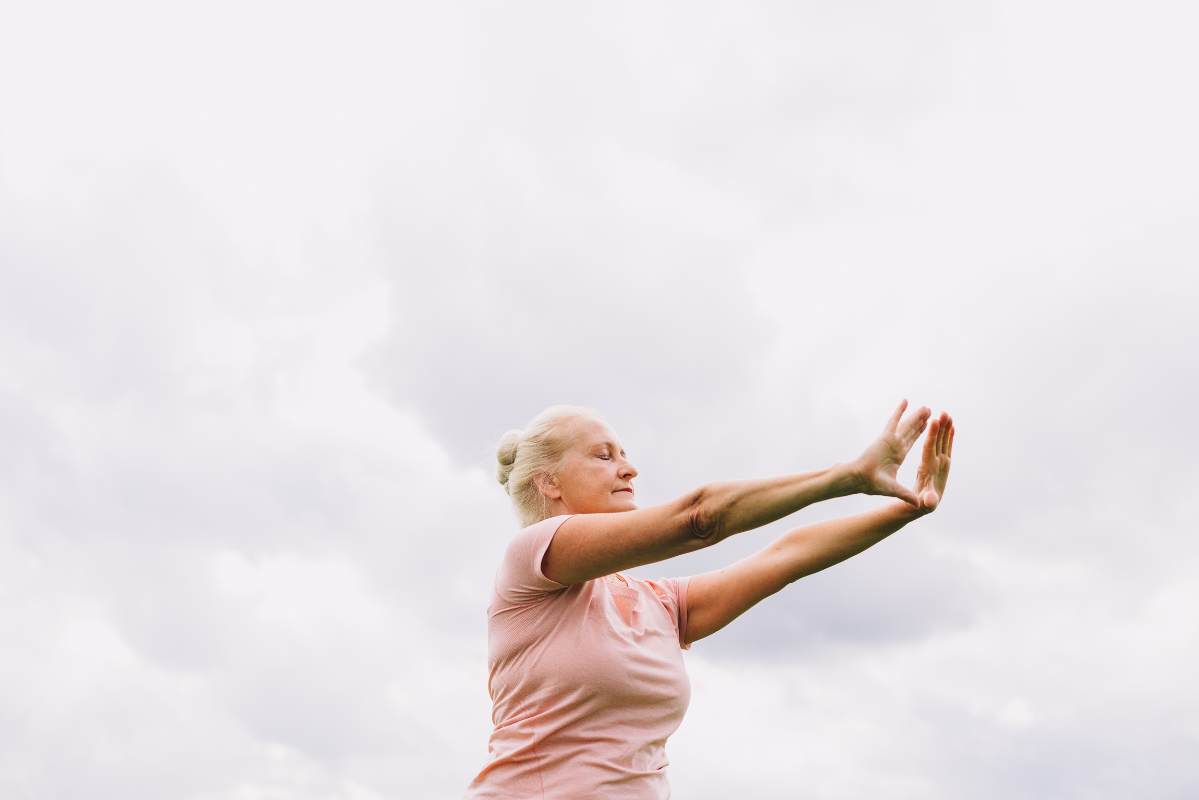 But here’s the beautiful news: strength training at any age helps reverse that.
But here’s the beautiful news: strength training at any age helps reverse that.
Start small—bodyweight exercises like squats at the kitchen counter, wall push-ups, or a gentle resistance band routine.
You don’t have to lift heavy weights to get strong—you just have to begin.
Be Kind to Yourself on the Off Days
Some days, movement just won’t happen. That’s not failure—it’s life.
 Midlife often comes with caregiving, work stress, poor sleep, and hormone shifts.
Midlife often comes with caregiving, work stress, poor sleep, and hormone shifts.
Give yourself grace. Rest is part of the process too.
Then, gently come back to your routine the next day. No guilt required.
Here’s the Truth: Movement Gives You Energy
 It might sound backwards, but the more you move, the more energized you feel.
It might sound backwards, but the more you move, the more energized you feel.
When done right, movement doesn’t deplete you—it renews you.
You’ll start to notice less joint pain, more stamina, better sleep, and even improved mood.
You Are Not Too Late—You’re Right On Time
Starting now, in the body you have today, is brave and beautiful.
 Whether you want to feel stronger, travel with ease, keep up with grandkids, or simply feel like yourself again—movement is a powerful key.
Whether you want to feel stronger, travel with ease, keep up with grandkids, or simply feel like yourself again—movement is a powerful key.
And you don’t have to do it alone.
If you’re ready to take that first step (or just want a little support getting started), I’d love to help you build a gentle, sustainable plan for strength and energy in this amazing stage of life.
Ready to Get Moving Again—Gently and Joyfully?
If you’re feeling stiff, tired, or unsure where to start, I’ve created something just for you.
This experience is designed to help you build strength, boost your energy, and feel good in your body again—without punishing workouts or overwhelm. Just simple, supportive movement that meets you exactly where you are.
👉 CLICK HERE to start your Journey!
Let’s move together—one small BUT powerful step at a time.
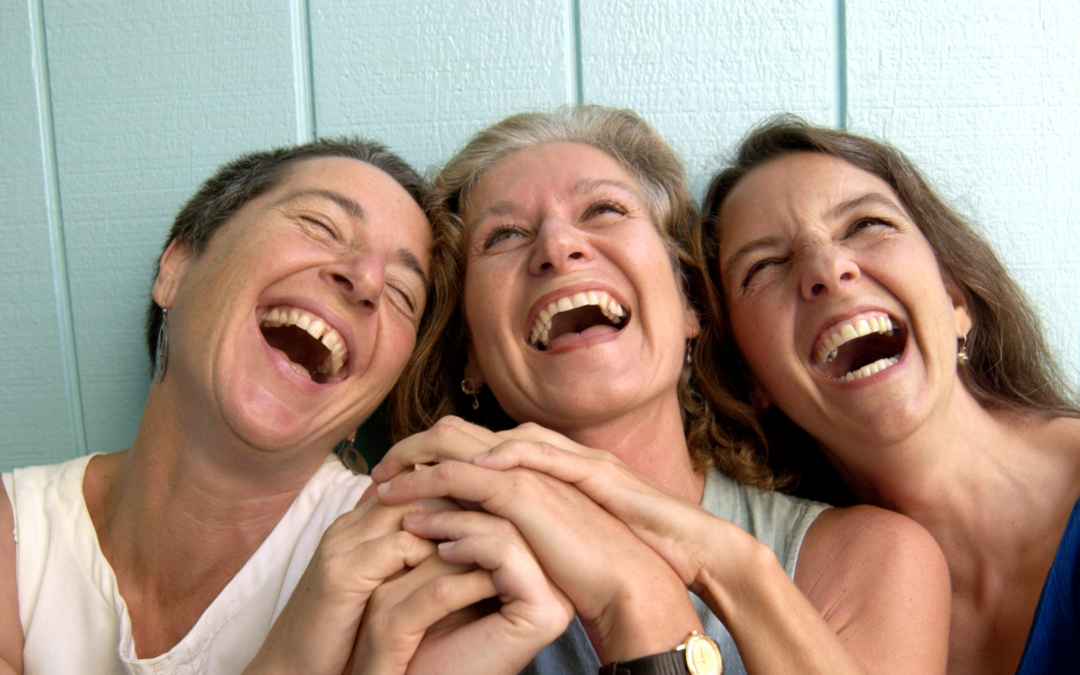
by Jo-Ann Brine | Menopause, Menopause, Midlife, Perimenopause |
Midlife can feel like a wake-up call. One minute you’re juggling work, family, and life like a pro, and the next, you’re wondering why your joints ache, your energy has dipped, and your body isn’t bouncing back like it used to.
But here’s the good news: midlife is the perfect time to invest in longevity—not just to live longer but to live stronger, healthier, and more vibrant into your 40s and beyond.
In this blog, we’ll cover exactly how to build longevity habits in your 40s, 50s, and 60s—without overhauling your entire life.
What Happens After Age 40?

Let’s start with the question many midlife women are asking: What really happens after age 40?
As we age, a few key changes begin to impact our health:
- Muscle mass starts to decline—up to 8% per decade after 40.
- Hormonal shifts, particularly around perimenopause and menopause, affect energy, mood, and metabolism.
- Bone density decreases, increasing the risk of fractures.
- Cognitive function may begin to decline slowly.
- And let’s not forget the stress, sleep disruptions, and weight gain that often creep in too.
These changes aren’t a reason to panic—they’re a reminder to get proactive. The choices you make today can have a powerful impact on your longevity tomorrow.
What Are the Biggest Midlife Health Risks?
 Understanding your risks is the first step to creating a solid longevity plan. The top health risks for women in midlife include:
Understanding your risks is the first step to creating a solid longevity plan. The top health risks for women in midlife include:
- Heart disease (the #1 killer of women)
- Type 2 diabetes
- Osteoporosis
- Cognitive decline (including Alzheimer’s)
- Obesity
- Chronic stress and depression
Many of these conditions are preventable—or at least manageable—with simple, sustainable lifestyle changes.
Midlife Longevity Habits That Make a Difference
 So what can you do now to set yourself up for a long, vibrant life? These five longevity habits are powerful tools for thriving in midlife and beyond.
So what can you do now to set yourself up for a long, vibrant life? These five longevity habits are powerful tools for thriving in midlife and beyond.
1. Move Your Body with Purpose
Regular movement is one of the best longevity tools we have. And no—you don’t have to run marathons or join CrossFit.

Focus on these three types of movement:
- Strength training 2–3 times per week to protect muscles and bones
- Daily walking to support cardiovascular health and mood
- Flexibility and balance training, like yoga or mobility work, to stay agile and prevent falls
Longevity Tip: Don’t aim for perfection—just aim to move more than you sit.
2. Prioritize Protein and Whole Foods

Nutrition doesn’t have to be complicated. Focus on:
- Plenty of lean protein to support muscle retention
- Colourful vegetables and fruits for fiber and antioxidants
- Healthy fats like olive oil, avocado, and nuts
- Whole grains for energy and heart health
Cut back on ultra-processed foods, added sugars, and anything that makes you feel bloated, sluggish, or foggy.
Longevity Tip: Eating for longevity isn’t about dieting—it’s about fueling your body for energy, strength, and healing.
3. Sleep Like It’s Your Job
Midlife sleep struggles are real, thanks to hormonal shifts, stress, and busy schedules. But sleep is non-negotiable for brain health, metabolism, and mood.

Try:
- A consistent sleep-wake schedule
- Limiting screen time 1 hour before bed
- Cooling down your bedroom
- Evening rituals like journaling or restorative yoga
Longevity Tip: Treat bedtime like a sacred ritual—not a last-minute afterthought.
4. Manage Stress Like a Pro
Midlife often brings more stress—aging parents, work changes, family demands. Chronic stress, however, accelerates aging at the cellular level.

Support your longevity by:
- Practicing daily breathwork or meditation
- Creating “white space” in your schedule
- Saying no to things that drain your energy
- Spending time in nature or with loved ones
Longevity Tip: Calm isn’t a luxury—it’s a strategy for long-term health.
5. Build Strong Social and Mental Health
Social isolation and cognitive decline often go hand-in-hand in older adults. But this is preventable!

- Stay socially connected
- Challenge your brain with new skills
- Cultivate joy and purpose (it’s not frivolous—it’s fuel!)
Longevity Tip: Your relationships and mindset may be just as important as your exercise plan.
Longevity Is a Lifestyle, Not a Quick Fix

If you’ve ever started (and stopped) a diet or wellness routine, you’re not alone. But the secret to midlife longevity isn’t in extremes or perfect plans—it’s in small, consistent habits that build over time.
Even just a few changes—walking more, strength training twice a week, adding more protein, going to bed 30 minutes earlier—can help you feel younger, stronger, and more like yourself again.
You’re Not Too Late—and You’re Not Alone
It’s never too late to choose longevity. Every step you take toward health now is a gift to your future self.
Whether you’re feeling tired, stressed, or like you’ve lost your spark, this can be your turning point. Not because you’re trying to be who you used to be—but because you’re becoming who you were always meant to be: strong, energized, and confident in your body and your choices.
You’ve still got decades of life ahead. Let’s make them count.
Ready to Take the First Step Toward a Longer, Stronger Life?
Don’t just read about longevity—start living it today.
Grab the Longevity Starter Kit to learn the exact habits and simple shifts that support energy, strength, and vibrant health in midlife.
👉 Download the Starter Kit here
And don’t do it alone! Join a community of like-minded women in The Midlife Wellness Lounge Facebook Group, where we share tips, encouragement, and real-life strategies for aging well—together.
Your journey to feeling amazing in your 40s, 50s, and beyond starts now.
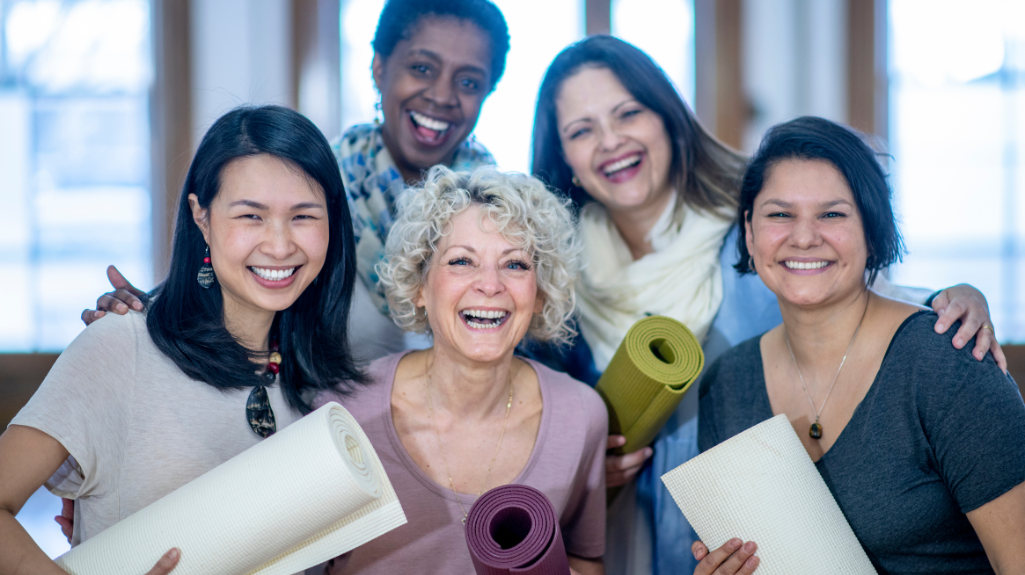
by Jo-Ann Brine | Menopause, Midlife, Perimenopause, Yoga |
Is exercise really that important for midlife women? Who has time for that??
YES! The answer is a resounding YES!
Exercise is important for people of all ages, but it becomes even more critical for women in midlife. Women in their 40s and 50s may begin to experience a variety of physical and hormonal changes that can negatively impact their health and well-being. Fun, right? It’s not all doom and gloom, though because exercise can help mitigate the results and symptoms that come along with some of these changes and improve overall health. The key is to be doing exercise that works with your body, and not against it.
Let’s dive in!
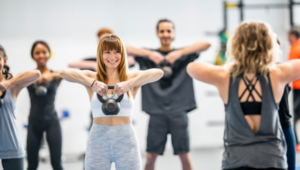
One of the most significant changes women in midlife experience is a decrease in estrogen levels. This decrease can lead to a range of symptoms, including hot flashes, night sweats, and vaginal dryness. And guess what? Exercise can help manage these symptoms!
Midlife women are also at a higher risk for other health conditions, including heart disease, osteoporosis, and type 2 diabetes. Exercise can help reduce the risk of developing these conditions by improving cardiovascular health, increasing bone density, and regulating blood sugar levels.
Regular exercise can also help midlife women maintain a healthy weight. As women age, their metabolism slows down, making it more challenging to maintain a healthy weight.
Good nutrition can help here too, but that’s a topic for another day 😀
Beyond the physical benefits, regular exercise can also improve mental health and cognitive function. Studies have shown that regular exercise can reduce the risk of depression and anxiety, improve memory and concentration, and increase overall cognitive function.
You may be wondering if there are specific exercises that are better for midlife women and the answer is YES!
Here are my suggestions for what to include in your exercise “routine”
Strength/Resistance Training
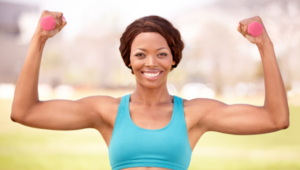
Strength training is first on my list as it’s the most important and one that we midlife women neglect. We lose muscle mass as we age and we need strength/resistance training to prevent this from happening. Using weights, resistance bands, or bodyweight exercises, can help improve bone density, maintain muscle mass, and boost metabolism. Aim for two full-body strength/resistance sessions per week, targeting major muscle groups like the legs, arms, chest, back, and core.
TIP: Start by doing squats without weights and gradually work up to adding weight or resistance bands. Try push-ups at the wall and as you get stronger, lower the incline to a counter, then to a bench, and finally to the floor.
Cardiovascular Exercise
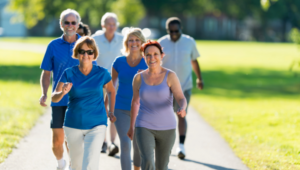
Cardiovascular exercise, such as walking, cycling, swimming, or dancing, can help improve heart health, reduce the risk of chronic diseases, and maintain a healthy weight. Aim for 2 or 3 30-45 minutes sessions of low/moderate-intensity cardio exercise per week. Don’t overdo it here, ladies. Get outside if you can.
TIP: Take short 5-10 minute walk breaks during your day. It all adds up 🙂
Flexibility
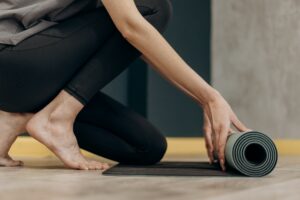
Flexibility exercises like stretching, yoga, pilates, or tai chi can help improve range of motion, reduce the risk of injury, and improve posture. Aim for at least two flexibility sessions per week or better yet, add a daily yoga routine to your repertoire. Short sessions more often can be better than fewer long sessions per week. 10 minutes a day is all you need but be warned, you may want to do more 😉
TIP: If you sit at a desk all day, take regular stretching breaks. Your body will thank you for it.
Mobility
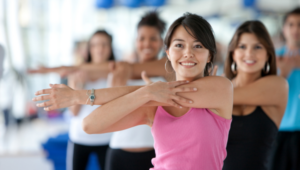
Mobility exercises are essential for midlife women to maintain flexibility, joint health, and overall physical function. As we age, our joints can become stiffer, and our range of motion can decrease. Mobility exercises can help maintain and improve joint health, reduce the risk of injury, and improve posture. Some examples of mobility exercises for midlife women are:
- Shoulder rolls
- Arm circles
- Ankle circles
- Hip circles
- Twists
TIP: Incorporate these moves into a warm-up or cool-down. Many mobility moves will already be included in a yoga class.
Balance
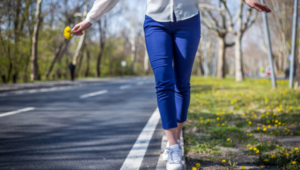
Balance exercises, such as standing on one foot, walking heel to toe, or doing balance poses in yoga, can help reduce the risk of falls and improve overall balance. A bonus of balance work is that it also works the core!
TIP: Try standing on one foot while standing in line at the grocery store. Or do a tree pose and see what kind of looks you get 😜
High-Intensity Interval Training
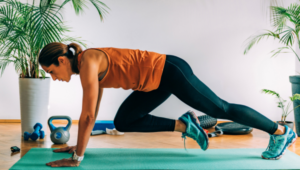
High-Intensity Interval training (HIIT) is a form of exercise that involves short bursts of high-intensity exercise followed by periods of rest. It can help improve cardiovascular health, increase metabolism, and burn calories in a short amount of time. However, it may not be suitable for everyone, especially those with certain health conditions or injuries. Try to keep HIIT to 45 minutes total per week, broken up into a minimum of 2 sessions.
TIP: Don’t complicate it. Make the exercise simple but intense enough to get the heart rate up.
Overall, exercise is essential for midlife women to maintain their health and well-being. Incorporating regular physical activity into their daily routine can help manage symptoms of menopause, reduce the risk of chronic conditions, maintain a healthy weight, and improve mental health and cognitive function. Bonus – Exercise also helps improve sleep when done early in the day…zzzzz!
Need some help getting started?

If you would like some guidance on what to do and how to incorporate more movement into your day, I invite you to check out my upcoming 7-day yoga/movement challenge for midlife women – CLICK HERE































 Understanding your risks is the first step to creating a solid longevity plan. The top health risks for women in midlife include:
Understanding your risks is the first step to creating a solid longevity plan. The top health risks for women in midlife include: So what can you do now to set yourself up for a long, vibrant life? These five longevity habits are powerful tools for thriving in midlife and beyond.
So what can you do now to set yourself up for a long, vibrant life? These five longevity habits are powerful tools for thriving in midlife and beyond.















